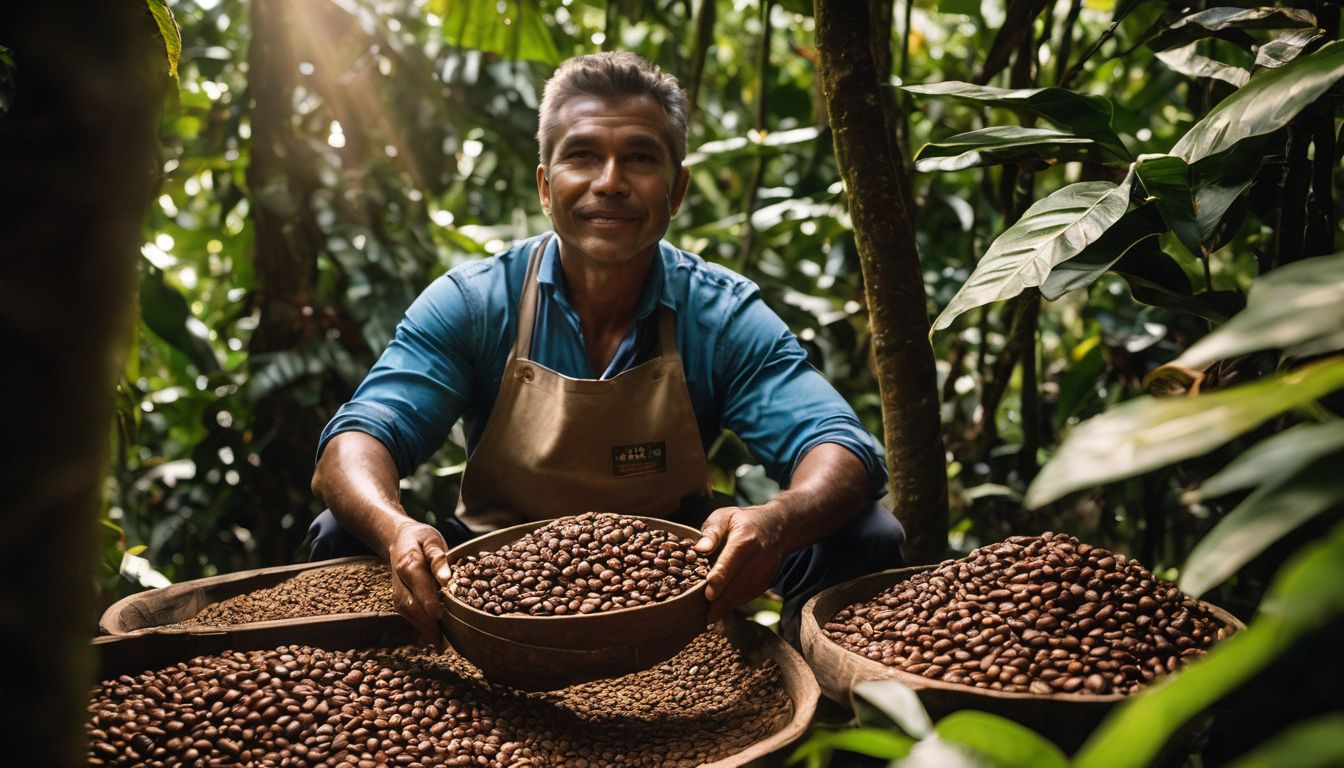Strolling down the aisles of your neighbourhood supermarket, you might find yourself pondering over the sheer amount of plastic packaging – a sight too familiar for comfort. We’ve all been in that position, feeling somewhat overwhelmed by our desire to contribute positively to the environment.
It’s quite staggering when you think about it; experts suggest a whopping 91% of plastic waste never sees the light of a recycling plant. But fret not! Our forthcoming article is carefully crafted with knowledge and advice from those in the know, aiming to demystify biodegradable and compostable options at your fingertips.
Let’s peel back the layers on this topic together for a future that’s evermore verdant.
Key Takeaways
- Biodegradable packaging is made from renewable resources like corn starch or sugarcane and can break down naturally with the help of bacteria, reducing landfill waste.
- PLA, a common type of bioplastic, is compostable under industrial conditions and offers an eco-friendly alternative to oil-based plastics for items like food packaging and disposable tableware.
- Choosing biodegradable and compostable products contributes to lowering our carbon footprint but may come with higher production costs and need specific conditions to degrade properly.
- To ensure proper disposal of these products, it’s crucial to find a local composting facility or learn home composting techniques to avoid disposing them as general waste.
- Educating consumers on the benefits and limitations of biodegradable packaging encourages informed choices that support sustainable consumerism.
Understanding Biodegradable and Compostable Products
Biodegradable packaging refers to materials that can break down naturally without causing harm to the environment, while bioplastics are made from renewable resources like corn or sugarcane.
PLA, or polylactic acid, is a common type of bioplastic used in packaging and is compostable under the right conditions.
What is biodegradable packaging?
We often talk about sustainable packaging, and that’s where biodegradable materials come into play. Imagine wrapping your sandwich in a material that can break down naturally over time, much like food scraps do.
That’s the essence of biodegradable packaging – it’s designed to decompose with the help of bacteria and other living organisms. This type of packaging isn’t made from traditional oil-based plastics which linger in our environment for centuries.
Instead, we use renewable resources such as corn starch or sugarcane to create this eco-friendly alternative. These plant-based materials ensure that when our packaging has served its purpose, it returns to the earth without leaving harmful residues behind.
By choosing these green alternatives, we make a positive contribution towards reducing landfill waste and mitigating environmental impact. Sustainable consumerism becomes part of our daily habits with choices like these – embracing products that safeguard nature for future generations while meeting our current needs.
What are bioplastics?
Understanding the shift from traditional plastics to more sustainable options is crucial in making informed choices for a greener future. Bioplastics, unlike oil-based plastics, are derived from renewable resources such as corn starch or sugarcane.
These materials can be broken down by microorganisms into biomass, carbon dioxide, and water under suitable conditions. This makes them an eco-friendly alternative with lower environmental impact compared to conventional plastics.
PLA (polylactic acid) is one example of a bioplastic that has gained popularity due to its compostable nature. Embracing bioplastics presents an opportunity to reduce reliance on non-renewable resources and lessen the environmental burden associated with traditional plastic production and disposal.
What is PLA?
PLA, or polylactic acid, is a bioplastic made from renewable resources such as corn starch or sugarcane. It is compostable and can break down into carbon dioxide and water in an industrial composting facility.
PLA is commonly used for food packaging, disposable tableware, 3D printing filament, and medical implants due to its biodegradability and low environmental impact. This eco-friendly alternative to traditional plastics reduces our reliance on finite fossil fuels and minimises harm to the environment.
Understanding the benefits of PLA helps us make informed choices towards sustainable living, but what are the pros and cons of biodegradable and compostable products?
Pros and Cons of Biodegradable and Compostable Products
Biodegradable and compostable packaging offers the benefit of reducing environmental impact, as they break down naturally without releasing harmful chemicals. However, their limitations include higher production costs and limited availability of composting facilities.
Benefits of biodegradable and compostable packaging
Biodegradable and compostable packaging offers numerous advantages, making it an excellent choice for environmentally conscious individuals. Here are the benefits:
- Reduces plastic pollution and landfill waste by breaking down naturally
- Lowers carbon footprint by using sustainable, renewable resources such as plant-based materials
- Decreases dependence on non-renewable resources like oil-based plastics
- Enhances soil quality when composted, providing valuable nutrients for plants
- Supports a circular economy by promoting the reuse of organic waste for creating new products
- Minimises environmental impact by producing fewer greenhouse gas emissions during decomposition
Limitations of biodegradable and compostable materials
Now, let’s consider the limitations of biodegradable and compostable materials:
- Biodegradable plastics may require specific conditions to degrade completely, such as high temperatures or industrial composting facilities.
- Some compostable products may not break down efficiently in home composting systems, requiring access to commercial composting facilities.
- The production of bioplastics often involves the use of agricultural resources, potentially impacting food production and land use.
- Biodegradable and compostable materials might not offer the same level of durability and shelf-life as traditional plastic products.
- Recycling options for biodegradable and compostable materials may be limited, leading to potential waste management challenges.
Difference Between Traditional Plastic Packaging and Biodegradable/Compostable Packaging
Traditional plastic packaging is made from oil-based plastics, which have a significant environmental impact. Biodegradable and compostable packaging, on the other hand, offers eco-friendly alternatives that can help mitigate the environmental impact of traditional plastics.
Environmental impact of traditional plastic
Traditional plastic packaging has a significant negative impact on the environment. Oil-based plastics take hundreds of years to decompose, contributing to the accumulation of non-biodegradable waste in landfills and oceans.
This results in harmful effects on wildlife and ecosystems, as well as adding to pollution levels through the release of toxic chemicals during production and disposal.
Furthermore, traditional plastic packaging contributes heavily to carbon emissions during its manufacturing process due to its reliance on fossil fuels. The extraction, transportation, and processing of these materials contribute to environmental degradation and climate change, making it imperative for us to seek alternative eco-friendly solutions such as biodegradable and compostable products.
Benefits of switching to biodegradable and compostable options
Switching to biodegradable and compostable options offers numerous benefits for the environment. These eco-friendly materials help in reducing the amount of waste that ends up in landfills, thus mitigating their impact on the environment.
By choosing biodegradable and compostable products, we can contribute to creating a greener future by supporting sustainable consumer choices and organic waste disposal.
Additionally, embracing these environmentally friendly alternatives encourages the use of sustainable materials and supports green living. It also helps in promoting eco-conscious choices, ultimately leading to a reduction in environmental impact.
How to Properly Dispose of Biodegradable and Compostable Products
To properly dispose of biodegradable and compostable products, it’s important to find a composting facility or learn how to compost at home. Educating customers on the proper disposal methods can also help in promoting environmentally friendly practices.
Finding a composting facility
To locate a composting facility, start by checking your local government’s waste management website for a list of approved facilities. Many local councils offer composting services for organic waste disposal, so you can drop off your biodegradable and compostable products there.
Eco-conscious individuals should consider partnering with local community gardens or farms, as they often accept organic materials for their composting initiatives. In addition, reach out to nearby sustainability-focused organisations or environmental groups inquiring about any available resources or recommendations for finding a suitable composting facility.
By actively seeking out these opportunities and engaging with the community, we can contribute to the proper disposal of biodegradable and compostable products.
Composting at home
Composting at home is a simple and effective way to reduce organic waste and enrich the soil. Here are some easy steps to get started:
- Choose a compost bin or create a compost pile in your backyard.
- Collect fruit and vegetable scraps, eggshells, coffee grounds, and yard waste for your compost.
- Layer brown materials like dried leaves or newspaper with green materials like food scraps to create a balanced compost mix.
- Turn the compost regularly to aerate it and speed up the decomposition process.
- Use the finished compost as nutrient – rich soil for gardening or landscaping.
Educating customers on proper disposal
Educating customers on proper disposal is crucial for the success of biodegradable and compostable products. We can make a significant impact by raising awareness about the importance of disposing of these items correctly.
This includes providing clear instructions on finding local composting facilities, guidelines for home composting, and information on the differences between traditional plastic packaging and eco-friendly options.
By educating our customers, we empower them to make informed choices for a greener future.
Conclusion: Making Informed Choices for a Greener Future
By choosing biodegradable and compostable products, we can actively reduce our environmental impact. These eco-friendly alternatives offer a sustainable solution to traditional plastic packaging.
Making informed choices today will contribute to a greener future for our planet. Let’s embrace eco-conscious decisions for a healthier environment.
FAQs
1. What are biodegradable and compostable products?
Biodegradable and compostable products break down naturally, helping reduce environmental impact by offering eco-friendly alternatives to oil-based plastics used in packaging materials.
2. Why should we choose biodegradable over traditional plastic items?
Choosing biodegradable products supports green living as they decompose faster than conventional plastics, aiding organic waste disposal without harming the environment.
3. How do compostable items benefit our planet?
Compostable items turn into nutrient-rich soil when disposed of properly, making them excellent eco-conscious choices for mitigating negative environmental impacts on our planet.
4. Can all degradable products be composted at home?
Not all degradable products can be home-composted; some require industrial facilities to break down completely, so it’s important to check if the product is suitable for your home composting setup.





